Very busy caterpillars that were doing more walking than eating in a nearly bare tree at the bottom of the garden first attracted my attention. My guess was that the caterpillars were getting ready to pupate, and so over the next few days I kept a look out hoping to find some pupae. It turned out that many of the caterpillars had been successful: I found dozens of butterfly pupae attached to leaves in nearby plants, and a few days after that, perching in the surrounding vegetation there were several butterflies with wings outstretched in the morning sunshine, these butterflies evidently from the first caterpillars to pupate. Inspecting the pupae, I found that several had hatched and some had newly emerged butterflies clinging onto the now empty shells. But as many of the pupae were still intact I couldn’t help thinking: If I keep careful watch I might actually witness a butterfly being born.
Of course it’s rather fanciful to say that butterflies are being born when they emerge from the pupae, although it is equally miraculous. It is perhaps more accurate to say that caterpillars are born when they hatch from the eggs laid by the previous generation of butterflies. How come I had not noticed that previous generation of butterflies in our garden? Perhaps there was something about this season that has made the caterpillars more abundant or perhaps I am becoming more observant?
And talking about being observant, I title this post an eye witness account, but looking at the header photo, one has to ask – who is watching who?

In this photo, one of the caterpillars (showing its branched and black-tipped spines) is walking rapidly while likely on the move to find a place to pupate. The host tree, Kiggelaria africana (Wild Peach) was eaten bare of most of its leaves and so the caterpillars moved to the neighbouring Curtisia dentata (Assegai) trees before pupating under the leaves there, or else descending to pupate on the slender leaves of the nearby Dietes grandiflora (Wild Iris) plants

A pupa attached with silk to the underside of a leaf of a Wild Iris plant that grows below the host tree that sustained dozens of hungry caterpillars
A butterfly pupa may appear to be dormant but a lot is going on inside as the caterpillar is reconfigured into a butterfly. Surprisingly, while in the pupa the transforming insect can show signs of being sensate and may shake or wriggle in response to a perceived threat, as I found when I turned over a leaf and found a pupa underneath. It knocked rapidly from side to side in response to my handling the leaf. Over ten days later I was happy to see the butterfly that eventually emerged unscathed.
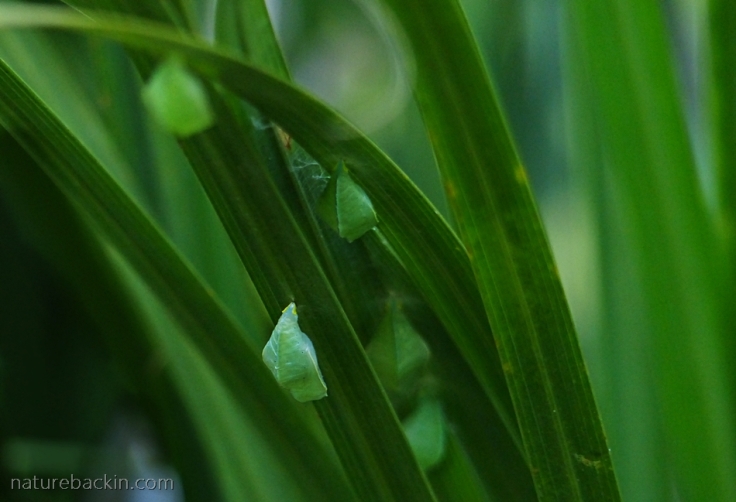
Hard to photograph, but this is an attempt to show something of the profusion of pupae adhering to the underside of the Wild Iris leaves
After seeing the hatched butterflies, the next morning I hastened down the garden to see what had happened during the night. Several more butterflies had emerged from the pupae and were hanging beneath the empty pupa shells expanding their wings that had been folded away for so long as they developed inside the pupa (or chrysalis).

A butterfly hanging beneath the pupa shell from which it had emerged about an hour before. This butterfly’s wings have entirely unfurled, but it takes more time for the wings to strengthen sufficiently before it can fly
After emerging from the pupa, a process termed eclosion, the wings of the butterfly are soft and folded. As the butterfly hangs upside-down underneath the shell of the pupa to which it clings, it pivots and swings and moves its wings up and down to pump body fluid into the veins so as to expand and strengthen the wings.

A close-up of a newly emerged butterfly suspended upside down hanging onto the empty casing of the pupa that had contained it. Note the partially unfurled tongue (proboscis) that appears to be a double tongue
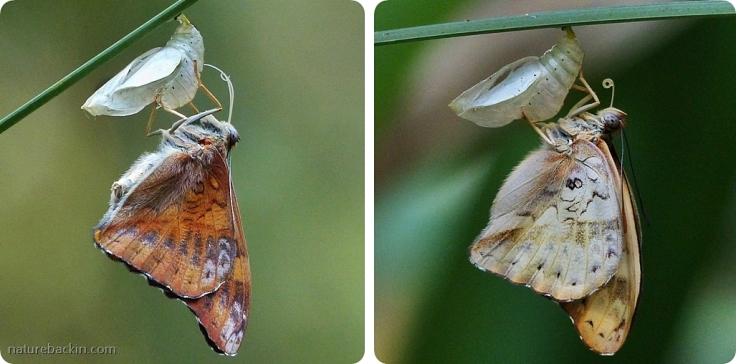
Two butterflies, a female on the left, and a male on the right, working at strengthening their wings and at the same time each one unfurling and stretching the proboscis and then furling it again
I was fascinated to watch the butterflies working hard to expand and strengthen their wings, and I also noticed that after hatching each continually worked the proboscis (tongue) and I thought (mistakenly) that each butterfly had a double proboscis. I was amazed to learn subsequently that the proboscis develops from two long C-shaped parts (termed galleae) that form separately in parallel to each other in the pupa. After emerging from the pupa the butterfly works the parts in order to fuse these two galleae together to form the hollow proboscis.
In Nymphalidae butterflies (including the species in these photos), when the newly emerged butterfly is actively uncoiling, disentangling and recoiling the galleae, it is actually working to interlock minuscule hooks that function to join the galleae together, using tiny drops of saliva-like fluid that contribute to the process. Assembling the two parts of the proboscis into one has to happen immediately after emerging from the pupa before the cuticle hardens. For a full description of this “once in a lifetime sequence of events” see here. Unfortunately, not all butterflies manage to assemble the proboscis properly in time, rendering them unable to use the incompletely fused proboscis to take in nectar and other fluids.

Initially green in colour, the pupae of this species of butterfly change in colour as the butterfly develops within it. In the photo above, an eye of the butterfly in the left-hand tip of the pupa is visible, as are parts of the folded wings. As the casing of the pupa softens prior to the butterfly emerging, it becomes more transparent

After an hour or two this butterfly’s wings have strengthened to the point that it can now perch upright. It is still a few hours away from being able to fly

Both intact pupae and the empty casings of butterflies that had flown remain attached to the leaves of a Wild Iris. It will not be long before the butterfly in the pupa on the left emerges, although I found it difficult to predict when that would happen with much accuracy
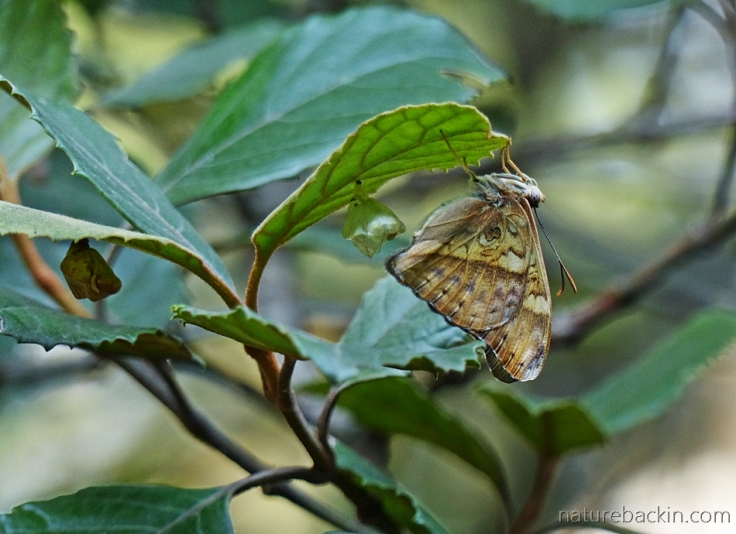
This butterfly hatched from a pupa attached to the underside of a leaf of a Curtisia dentata tree, which neighbours the larval host tree. Another pupa can be seen to the left. I think that this is a male butterfly, although it can sometimes be hard to tell from the underside of the wings, as the colour varies depending on the brightness of the light and on how the wing is angled to the light
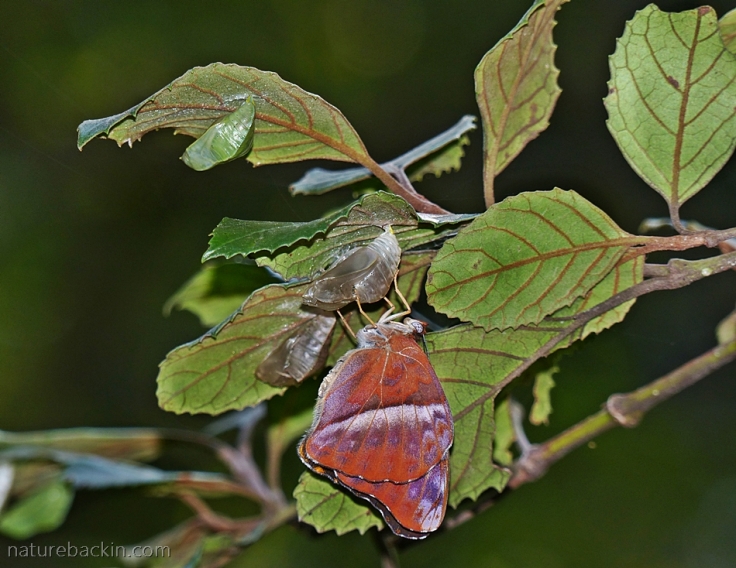
I used the camera flash to photograph this female butterfly still hanging onto the pupa shell after she emerged from it. Her wings are still soft. Behind is another empty pupa and above that a still intact pupa can be seen under leaves of the Curtisia dentata

And this is a male warming his wings in the morning sunlight prior to taking his first flight
Having seen so many butterflies at various stages of their development, I was starting to figure out the colour differences that I found confusing at first. I consulted my Pocket Guide to Butterflies of Southern Africa and also looked at butterfly images on line, and concluded that these butterflies are known as the Battling Glider (Cymathoe alcimeda). They belong to the large Nymphalidae family of butterfly, comprising over 6000 species. Gliders belong to the subfamily Limenitinae.
Most species of butterfly in the Nymphalidae family walk on two pairs of legs as the size of the front pair of legs is significantly diminished relative to the other two pairs. Because these forelegs sport brush-like hairs Nymphalidae are referred to as brush-footed butterflies.
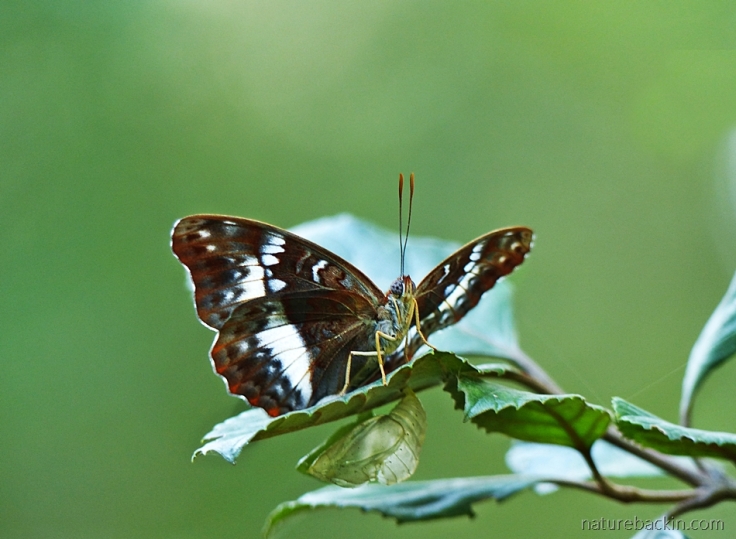
Rather dramatically lit by early morning light, this female butterfly has moved around to the top of the leaf to perch while moving her wings up and down to strengthen the wings as they harden. Three pupa, one unhatched, can be seen below the leaf on which she perches. Although the small forelegs of the butterfly cannot be seen in this photograph, it is clear that the butterfly is standing on only four legs
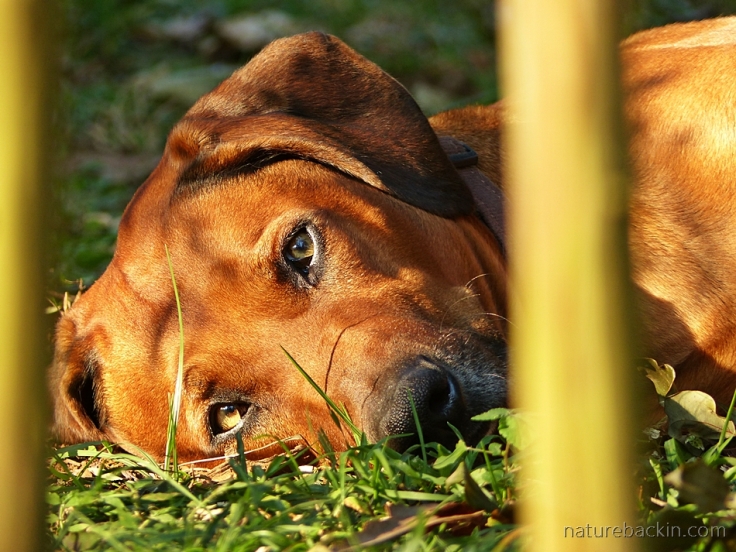
Of course not everyone finds spending hours watching butterflies rewarding. One of our dogs, Rory, lay down resignedly on the grass to watch me, clearly signalling that he is fed up. He is on the other side of a fence as otherwise he likes to sit close, and that rather disturbs what I am looking at and gets in the way of the camera!
While taking these photos and hoping to be able to see a butterfly actually in the process of emerging from its pupa, I took a few videos, including of butterflies expanding and strengthening their wings and some clips of a butterfly working on assembling its proboscis. (Unfortunately, the intermittent wind makes for a bit of extra movement at times.)

I am fond of this photo of a female Battling Glider, with her wings still noticeably soft, as she continues to strengthen and warm her wings in the early morning light

Of course so many butterflies flitting about on their maiden flights proved easy prey to waiting birds, including this Forktailed Drongo, keeping a sharp eye out from a nearby tree. I think my presence watching the butterflies hatch was a deterrent to the birds and may have prolonged the lives of several butterflies by a few hours at least
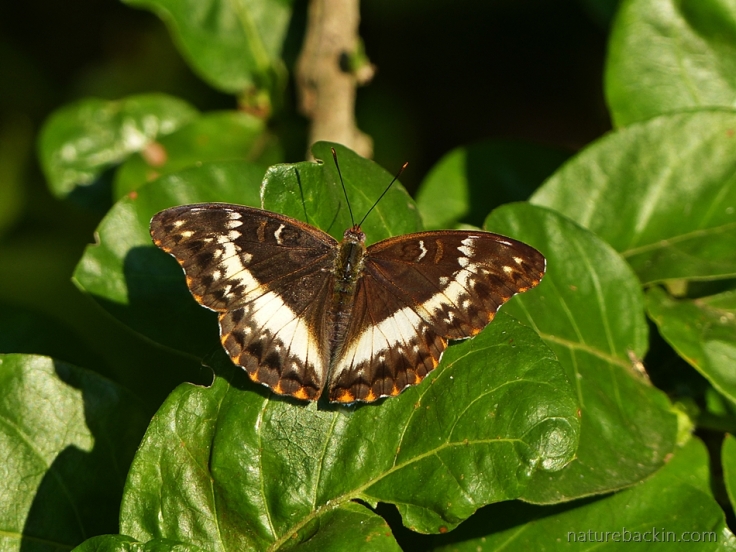
In its full glory, this female Battling Glider has done a bit of flying before settling again to warm her wings further in the autumn sunshine

A female Battling Glider with the wings folded, showing how different the underside of the wing is from the upper side as seen in the photo above this one. Depending on the light, sometimes the underside of the wing looks to be really red, at other times more amber, and sometimes much paler

This photo of a male Battling Glider butterfly clearly shows the difference between the upperside and the underside of the wings
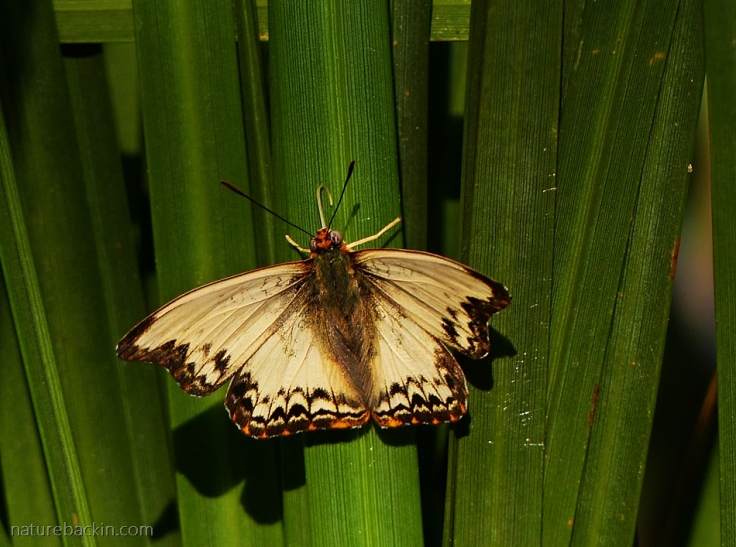
Getting stronger and stronger in the morning sunlight, this male Battling Glider butterfly, after strengthening his wings and assembling his proboscis into one unit, is crawling up to the top of the leaves of the Wild Iris plant that hosted him during his long pupate stage. The fused proboscis can be clearly seen as it is uncoiled against the leaf
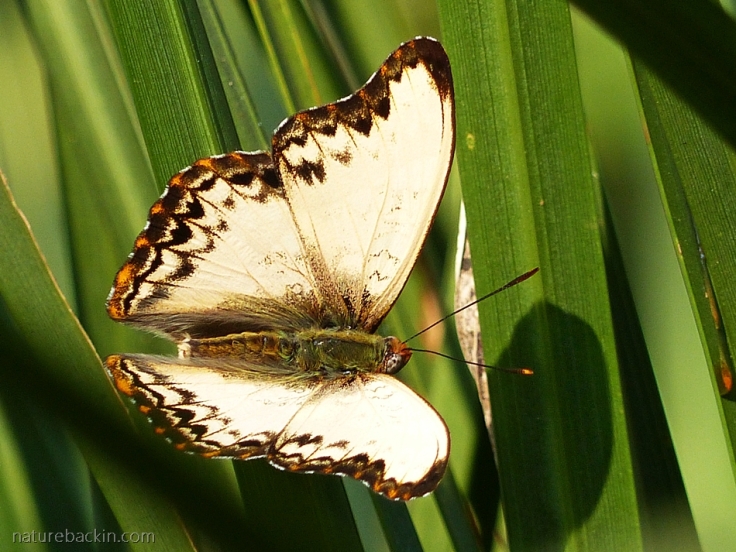
And here he is nearly ready to fly!
While taking these photos I had still had not managed to time it right to see a butterfly actually emerging from the pupa. But I finally did! And I was able to photograph butterflies emerging and even managed to take some video footage. However, I think that this post is long enough already, and so there’s more, but wait, only next week!
To be continued …
Sources:
Eeles, P. 2015. Butterfly Anatomy. Dispar: The Online Journal of Lepidoptera. http://www.dispar.org/reference.php?id=6; Krenn, H. W. 1997. Proboscis assembly in butterflies (Lepidoptera) – a once in a lifetime sequence of events. European Journal of Entomology, 94 (4): 495-501. https://www.eje.cz/artkey/eje-199704-0012_Proboscis_assembly_in_butterflies_Lepidoptera_-_a_once_in_a_lifetime_sequence_of_events.php; Woodhall, Steve. 2013. Butterflies of South Africa. Pocket Guide. Cape Town: Struik Nature.
Posted by Carol

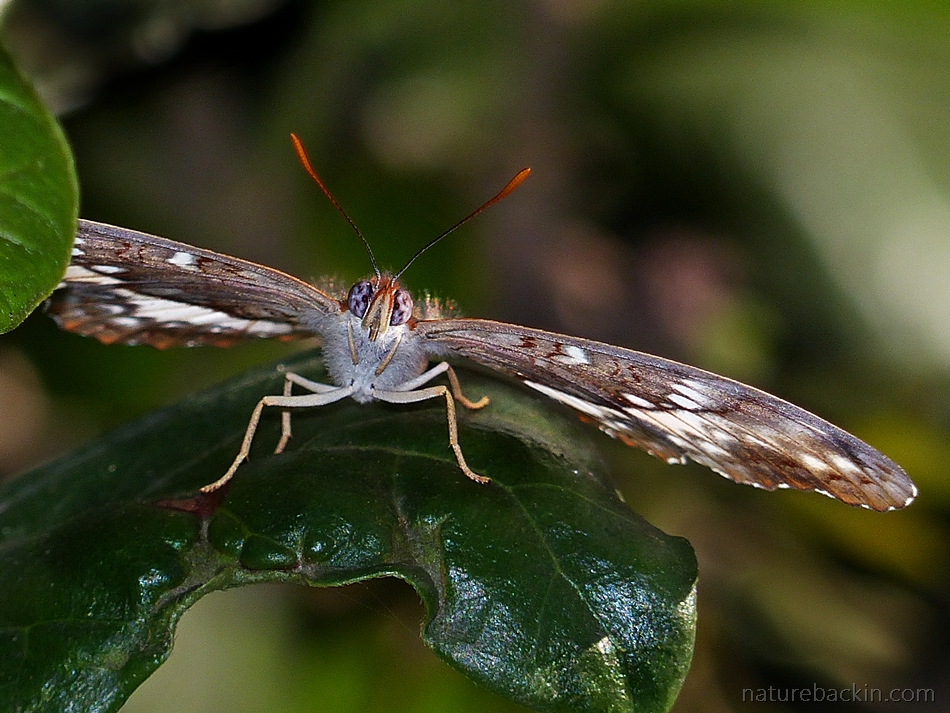







June 12, 2019 at 10:14 am
I Only had the opportunity to intensely read this wonderful blog today, Carol. Wondering why the two tongues have to emerge and only at that point come together? Why not one tongue from the start? Nature is so fascinating! Excellent pictures and video!
LikeLiked by 1 person
June 13, 2019 at 7:15 pm
Thank you Suzette. It was great to share my fascination for the whole process. Regarding the tongue being in two parts, I gathered from what I read that the tongue forms from transformed mouth parts of the caterpillar, so perhaps this explains why it develops as it does. The complexity of the transformation from caterpillar to butterfly that takes place within the pupa is mind blowing.
LikeLike
June 6, 2019 at 7:46 pm
As you know, I’ve been away, so I deliberately held back from reading your post until I had a decent sized screen to read it from. I was right to do so. This is a fascinating post, and that video is simply wonderful. It hadn’t occurred to me that the process of emerging, drying out and generally getting ready to face the world was such a long-drawn out process – in such a short life. I’ll look at our own garden butterflies with increased respect.
LikeLiked by 1 person
June 7, 2019 at 7:12 am
Thanks Margaret and welcome home after your amazing surprise reunion. I was also stunned at the processes butterflies and caterpillars go through as they metamorphosise. The intricacy and complexity and on such a scale is extraordinary. Microchips are perhaps simple by comparison 🙂 I too look at these creatures with a whole new respect.
LikeLiked by 1 person
June 6, 2019 at 11:13 am
Carol as always I’m enchanted by your astute observation illustrated by superb photography! Can’t wait for the next installment, thank you!
LikeLiked by 1 person
June 6, 2019 at 4:54 pm
Thanks very much Christeen. I have been a bit butterfly obsessed, but I will be changing my gaze after the next post 🙂
LikeLiked by 1 person
June 7, 2019 at 3:28 am
It is great to focus on one aspect sometimes, that gives greater depth! xxx
LikeLiked by 1 person
June 7, 2019 at 7:30 am
It certainly was an intense experience. Quite transporting at the same time. It beats meditating sitting on a cushion 🙂
LikeLike
June 3, 2019 at 3:24 pm
An amazing post Carol. The images are superb but the amount of info about these wild creatures is really wonderful too. Also the video is incredible. Thanks so much for posting in our challenge. It’s perfect!
LikeLiked by 1 person
June 3, 2019 at 9:16 pm
Thanks very much Tina.
LikeLike
June 3, 2019 at 2:35 am
Another beautifully put together piece, Carol! Fascinating to read with photographs that are a feast to the eyes. Thank you so much for making my Monday morning!
LikeLiked by 1 person
June 3, 2019 at 5:07 am
Thank you Dries. Glad the post helped you ease into Monday. Have a good week.
LikeLiked by 1 person
June 1, 2019 at 7:37 pm
Fascinating – great privilege to be able to observe this timeless miracle.
LikeLiked by 1 person
June 2, 2019 at 6:07 am
Absolutely is a privilege and fascinating to watch. The intricacy of the process is incredible.
LikeLiked by 1 person
June 1, 2019 at 3:38 pm
Brilliant post, Carol. Like every time 😊
LikeLiked by 1 person
June 2, 2019 at 6:04 am
Thanks Simone 😊
LikeLiked by 1 person
June 1, 2019 at 6:44 am
This was utterly amazing. Waiting impatiently for the next post! Your images are absolutely exquisite. Your research also adds so much to the post. I am always happy to see your post land in my inbox.
LikeLiked by 1 person
June 1, 2019 at 1:05 pm
Thanks very much Gunta. We were pretty amazed, and I spent a lot of time watching them as not sure if I will ever be presented with such an opportunity again. It was a lot more fun and more engrossing than might be imagined 🙂
LikeLike
June 1, 2019 at 6:24 am
I’m wildly envious of the profusion of pupae in your garden. I’ve seen exactly one here, and I do look for them – obviously in the wrong places. These are beautiful photos of a beautiful butterfly and I learn something from each of your posts. Looking forward to the next installment.
LikeLiked by 1 person
June 1, 2019 at 1:01 pm
Well we have lived here for 12 years and this is first time I have noticed so many butterfly pupae. I have no idea if there are more, or, as I said, if I have become more observant – or perhaps just lucky. End result is that I now have a habit of peeking under leaves! Have had some interesting finds but many too small for my camera to photograph,
LikeLiked by 1 person
June 2, 2019 at 4:52 pm
I’ll have to be thorough in my examination of the leaves!
LikeLiked by 1 person
June 3, 2019 at 5:06 am
Seeing is beleaving …
LikeLiked by 1 person
June 4, 2019 at 5:11 am
Oooooh, I do like that!
LikeLiked by 1 person
June 6, 2019 at 4:51 pm
🙂
LikeLike
May 31, 2019 at 7:35 pm
Unbelievably beautiful pictures! And so many pupae on one plant. Maybe they are more this year! We currently have processionary worms in the garden. They are most fascinating to watch as they slowly march in a huge line to the next tree!
LikeLiked by 1 person
June 1, 2019 at 12:58 pm
Thank you Lizam. Yes the sheer number was amazing. Oddly, in contrast I have only seen two and then four processionary caterpillars in the garden this season, and usually there are many in our crossberry tree. Perhaps they are late this year or it’s not a good year. They are totally fascinating. I have done several posts featuring processionary caterpillars. In case you are interested, here is a link to one of them: https://naturebackin.com/2016/08/04/following-the-silk-road-processionary-caterpillars-anaphe-reticulata-in-our-garden-part-1/
LikeLike
May 31, 2019 at 5:36 pm
These are all wonderful Carol! How lovely to be apart of all of this!
LikeLiked by 1 person
June 1, 2019 at 12:53 pm
Thank you Pete. Yes it was lovely to be involved in such a special occasion. I even developed affinities for some individuals and kept checking on their progress 🙂
LikeLiked by 1 person
May 31, 2019 at 9:11 am
Simply stunning! The video of the butterfly is mesmerising. Superb post Carol, bring on next week!
LikeLiked by 1 person
May 31, 2019 at 11:55 am
Thanks very much Sandra. Glad you liked the video. I was surprised how the random clips ended up sort of complementing each other. I need to start putting together the clips I took for next week!
LikeLiked by 1 person
May 31, 2019 at 8:06 am
Tremendous! I’m green with envy, your garden has some amazing wildlife!
LikeLiked by 1 person
May 31, 2019 at 11:53 am
Thanks so much. We are very lucky to have so much wildlife about, and it does help to plant native plants that provide for so many creatures and encourages them to stick around.
LikeLiked by 1 person
May 31, 2019 at 7:36 am
Carol, I always look forward to your posts. I have learned so much from this one!
LikeLiked by 1 person
May 31, 2019 at 11:51 am
Thank you for your generous comment Anne. I learned a lot too from watching them and then reading up a bit about these butterflies. They are enchanting too!
LikeLike
May 31, 2019 at 12:52 am
Wow! These are amazing shots. ❤️
LikeLiked by 1 person
May 31, 2019 at 11:50 am
Thank you very much Irene. It helps a lot when the butterflies are not yet flighty!
LikeLiked by 1 person
May 30, 2019 at 11:38 pm
Impressive documentation of this process, Carol. So interesting about the fusing of the proboscis!
LikeLiked by 1 person
May 31, 2019 at 11:49 am
Thank you Eliza. I was also amazed at the intricacy of the proboscis and its assembly.
LikeLike
May 30, 2019 at 10:24 pm
A lovely post, but I had to adjust my thinking on the video, I was expecting a Tweedledum and Tweedledee kind of battle, with perhaps the appearance of a monstrous crow!
LikeLiked by 1 person
May 31, 2019 at 11:48 am
Not that kind of battlers fortunately 🙂 And only a hungry drongo rather than the monstrous crow.
LikeLike
May 30, 2019 at 9:26 pm
Reblogged this on A Tale Unfolds and commented:
A marvelous butterfly post, from Carol who lives and works in Kwazulu, Natal, South Africa.
Definitely worth a visit.
LikeLike
May 30, 2019 at 9:23 pm
Superb! Well done, Carol. Never seen this species up here in Jo’burg.
I am going to re-blog this post.
I know at least one of my visitors, Brian, will be fascinated by this.
LikeLiked by 1 person
May 31, 2019 at 11:32 am
Thanks so much for reblogging this post Ark. They are gorgeous butterflies – they prefer escarpment forest I gather so perhaps won’t venture into Jhb. They are mostly in the eastern parts of the country and in the northeastern forested bits.
LikeLiked by 1 person
May 31, 2019 at 11:35 am
My pleasure, Carol. Definitely a post with re-blogging, and I see my blogpal, Brian from England has paid you a visit.
He’s a bit nuts about butterflies, but don’t tell him said so!
😉
LikeLiked by 1 person
May 31, 2019 at 12:00 pm
Yes I visit Brian’s blog now and again and his photos are fantastic.
LikeLiked by 1 person
May 31, 2019 at 12:30 pm
Aaah, they’re not that good.
Besides, you can’t credit anyone who supports Norwich Football Club with that much talent!
😉
LikeLiked by 1 person
June 1, 2019 at 12:48 pm
What I know about football is only marginally more than the zero I know about drag racing. For some very obscure reason I associate Norwich with a nursery rhyme about the man in the moon. I wonder why that is?!
LikeLiked by 1 person